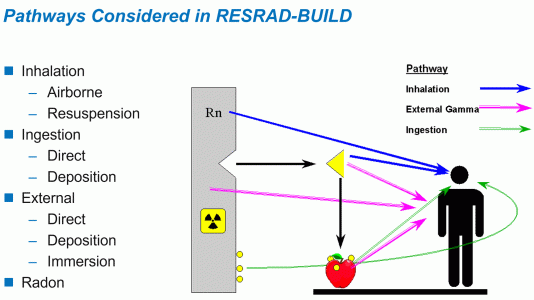
The RESRAD-BUILD computer code models radionuclide release and transport in indoor environments. The code links a radiation source to individual receptors at specific locations inside a building via pathway analyses to evaluate the potential radiation doses and cancer risks incurred by those receptors.
Version 4 of RESRAD-BUILD has many modeling enhancements and new features. A few major enhancements include:
- Analysis of buildings with up to 9 rooms or compartments.
- Modeling of all branches of the decay transformation chain with choice of International Commission on Radiological Protection (ICRP) Publication 107 or ICRP Publication 38 transformation data.
- Allows independent choice of a set of internal dose, external dose, and risk radiological data libraries.
- Additional dose and risk libraries associated with ICRP Publication 107 transformation data.
- Models vacuuming at regular intervals.
- Models varied rates of resuspension in different rooms.
- Models delayed and intermittent releases of source material from point, line, or area sources.
- Models releases over up to 10 different periods of time, each at a different release rate.
- Unambiguous specification of the location and the orientation of the contaminated region for volume sources.
- Interface and user help enhancements.
Dynamic ventilation model
In RESRAD-BUILD version 4.0, a dynamic ventilation model simulates the fate and transport of source material particles and radionuclides after their releases. This dynamic ventilation model considers (1) air exchange between rooms in the building and between the rooms and the outdoor environment, (2) deposition from air to floor, (3) resuspension from the floor to the air, and (4) periodical vacuuming that reduces the floor deposition. The fate and transport modeling provides estimates of radionuclide concentrations in the source, in the air, and on the floor at different times, which are then integrated over the exposure duration for the calculation of radiation doses and cancer risks.
Exposure pathways
A single run of the RESRAD-BUILD code can model a building with up to 9 rooms, 10 sources, and 10 receptors. The potential radiation dose and cancer risk incurred by each receptor are calculated for seven exposure pathways: (1) external radiation directly from the sources (accounting for shielding), (2) external radiation from radioactive particles deposited on the floors, (3) external radiation from airborne radionuclides, (4) inhalation of airborne radionuclides, (5) inhalation of radon and radon progenies, (6) inadvertent ingestion of radioactive particles directly from the source, and (7) ingestion of radioactive particles deposited on the floors. Various exposure scenarios can be modeled with RESRAD-BUILD, including but are not limited to, office worker, renovation worker, decontamination worker, building visitor, and resident. Both deterministic and probabilistic analyses can be performed to obtain results in both text reports and graphic displays.
Learn more
RESRAD-BUILD Code Version 4 and supporting documentation can be download from the RESRAD website.
RESRAD-BUILD is part of the RESRAD Family of Codes that Argonne National Laboratory’s Environmental Science Division developed for the U.S. Department of Energy and the U.S. Nuclear Regulatory Commission.
The RESRAD family of codes has been used by health physicists and radiological engineers in more than 135 countries as a tool for deriving cleanup criteria and radiological risk assessment for releasing contaminated sites. Over 1,000 journal and other papers have been published – either based on or citing – RESRAD codes. Over 130 training courses have been conducted with more than 2,500 participants. RESRAD codes and supporting documents can be freely downloaded from the RESRAD website.